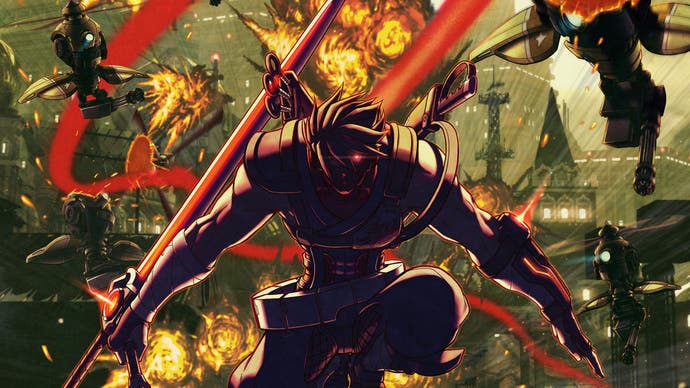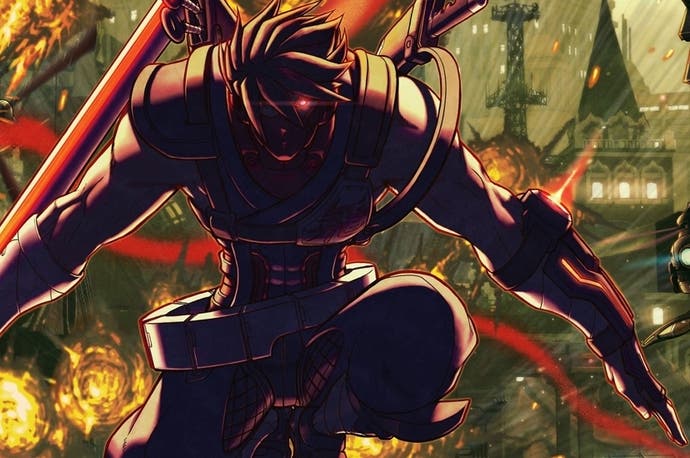Strider's revival could be the classic's best sequel yet
Double Helix's involvement may have raised suspicions, but this is a solid if safe revival for Capcom's icon.
Be careful what you wish for. Kouichi Yotsui's Strider series burnt short but bright, and ever since its technically challenged but mechanically exquisite sequel came out in arcades 16 years ago, those still basking in its afterglow have been pining up for a follow-up.
Bar a handful of cameos in Marvel vs. Capcom, though, there's been silence - until San Diego Comic Con earlier this year, that is, when Strider Hiryu's comeback was announced. But it's a double-edged cypher blade: Capcom's new game is a reboot being handled by Double Helix, a studio whose less than stellar back catalogue includes lowlights such as Battleship and Silent Hill Homecoming.
In the immediate wake of Spark's sadly predictable fumbling of Lost Planet 3 - as well as Capcom's announcement earlier this year that it would be dialling back external collaborations given the disappointing results thus far - the reboot feels like a slightly retrograde step.
Yet Double Helix's Strider, it turns out, was green-lit well before the Osaka outfit's change of policy, with the wheels being set in motion on the project over two years ago. Producer James Vance, who's working from Capcom's Japan headquarters, doesn't believe the about-turn will have any impact on Strider, either.
"From a corporate perspective there have been some implications, but as a project leader you just want to stay focussed on your project," he tells us. "And we have faith that our project on its own is a good project, and we're intent on delivering the best thing we can. In a sense it kind of exists in a vacuum."

From that vacuum there seems to be forming something of a surprise, and more importantly a reboot that does enough to satiate the appetites of Strider's somewhat famished fan-base. There's a conservatism in this Strider reboot, but it's one that's managed to preserve all the pillars of the series: the gorgeous parabola of Strider's jump, that fierce floor slide and the vicious flash-strike of blade are all present and, largely, as you remember them. It's a game built around Strider and his abilities, and it's pleasing that the basics are at least present and correct, even if there have been tweaks.
"A key thing in creating this game was the feel of the Strider Hiryu character," explains Vance. "Going from the old-school thing where as fast as you smash the button he'll slash his sword. Even when you go back and play the old game, it's not as fluid as something you'd play these days, but at the time it really felt like that. So the thing was, what's the memory you have of the game rather than how it actually was. How did it feel? And it felt acrobatic, you could do cartwheel flips through the air. The character had to be really fluid, and really dynamic - and instantly respond."
There'll be arguments about how authentic Strider's jump arc now is, but there shouldn't be about the backdrop and world that he finds himself in. There are the explicit touches - Meio's laugh echoes out over the start screen, and the opening level happily lifts the bubbling chiptune track from the opening of the first game - but there are more subtle throwbacks too. Double Helix is doing the heavy lifting, but there's a fair amount of guidance coming from Osaka, and from a lot of the team that worked on Strider 2. Character art is coming from Capcom before being modelled by the Californian studio, and design concepts are too.
So while Yotsui himself isn't involved, Vance believes there's still a strong link to the originals. "We felt that we had the artist, so we thought he had the pedigree to support that, plus there was a whole bunch of other staff who were connected to Strider 2. So we felt that we had enough of the mindshare to make good on the series rather than reaching out to the original creator."
Capcom and Double Helix may well have succeeded where Yotsui failed, too. Moon Diver, the side-scrolling action outing from the Strider creator that came out a couple of years back, obscured the original template with scrappy co-op. This reboot's been wise to keep things simple at the core while spreading it outwards towards a Metroidvania-style game, its levels sprawling out and divided by gear-gating that's accelerated in the short demo.
That gear's wisely in keeping with the original's spirit too, if the upgrades being shown right now are anything to go by. There are different flavoured cypher swords, a charge attack and one that deflects bullets back at enemies, while the Osaka crew contributed a plasma catapult that spirits Strider across the screen.
What's best, though, is that this new Strider puts up a significant challenge, dispatching less skilled players at a rate that would make its predecessor proud. There's an emphasis on momentum, although it is of a slightly different bent to the original - this time it's about coursing forwards, cypher blade flashing as you dispatch with enemies as quickly as possible in order to fill a combo meter that amplifies your attack power when filled.
It's a different type of Strider then, but one that is in many ways faithful to the 1989 classic - and one that more successfully builds upon the original formula than perhaps any other game has since. Double Helix's reboot won't quite have the same muscular impact, but it's a new Strider game that deserves its name. Despite some understandable reservations, this looks like it could well see a wish fulfilled.


